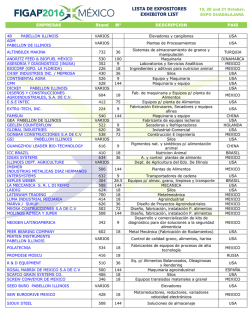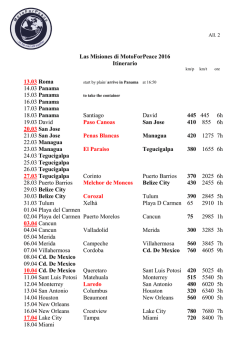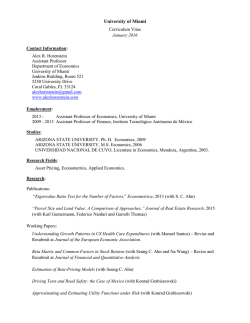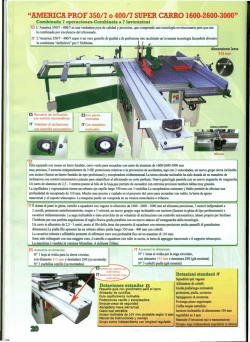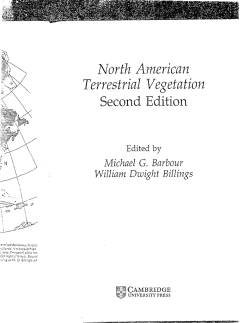
Biogeographical affinities among Neotropical cloud forest (PDF
Plant Syst. Evol. 228: 229±239 (2001) Biogeographical anities among Neotropical cloud forests I. Luna-Vega1 , J. J. Morrone2 , O. AlcaÂntara Ayala1 , and D. Espinosa Organista3 1 Herbario FCME, Facultad de Ciencias, UNAM, Mexico D.F., Mexico Museo de Zoologõ a ``Alfonso L. Herrera'', Facultad de Ciencias, UNAM, Mexico D.F., Mexico 3 Herbario, Facultad de Estudios Superiores Zaragoza, UNAM, Col. EjeÂrcito de Oriente, Iztapalapa, Mexico D.F., Mexico 2 Received February 22, 2001 Accepted May 1, 2001 Abstract. Biogeographical anities among cloud forests in the Neotropical region were studied through a track approach, by constructing generalised tracks based on the results of a parsimony analysis of endemicity (PAE). Distributional data on 946 genera and 1,266 species of vascular plants (Pteridophyta, angiosperms, and gymnosperms) from 26 cloud forest patches from Colombia, Costa Rica, Cuba, Honduras, Jamaica, Mexico, Peru, Puerto Rico, and Venezuela were analysed; and four localities from eastern and western United States were also included as outgroups. The track analysis identi®ed six generalised tracks: a ®rst one that includes the majority of the cloud forests of Mexico, Central America, the Antilles, and northern Colombia; a second one that includes southern Mexico and northern Central America; a third one that includes the mountains in northwestern South America; a fourth one that includes the mountains in southwestern South America; and two others in western and eastern United States. It is concluded that the Neotropical cloud forests are closely related and that those of the Caribbean subregion exhibit complex relationships, which could be due to the complex tectonic history of the area. Key words: Neotropics, cloud forests, vascular plants, panbiogeography, track analysis, parsimony analysis of endemicity. Introduction The Neotropical region ranges in the Americas, from central Mexico to central Argentina (Morrone 1999, Morrone et al. 1999). This biogeographic region is characterised by its great diversity of ecosystems, which include among others, steppes, grasslands, savannas, moorlands, and dry, moist, and cloud forests (Cabrera and Willink 1973, Dinerstein et al. 1995). Within the Neotropical ecosystems, cloud forests are particularly interesting from a biogeographic viewpoint (Luna et al. 1999). The northernmost stand of cloud forest is found in the Sierra de San Carlos and GoÂmez Farõ as (Tamaulipas), in the Mexican Sierra Madre Oriental, between 1,300 and 1,400 m (Briones 1991). The southernmost cloud forest is found in northeastern Argentina, at approximately 27±28° S (Webster 1995). Neotropical cloud forests are characterised by their archipelagic distribution, the presence of endemic taxa, and their high biodiversity, which highlight their biogeographic and biological importance. They have been considered also as one of the main world centres of domestication of certain plants such as corn, beans, peppers and tobacco, which have been 230 I. Luna-Vega et al.: Biogeography of Neotropical cloud forests clues to the ¯ourishment of Pre-Columbian civilizations. Neotropical mountains harbour ca. 45,000 species of ¯owering plants, which when compared to the 250,000 species worldwide, show that they constitute one of the world's great centres of biological diversity (Churchill et al. 1995). Recently, attention has been placed in the study of these Neotropical montane forests, including principally their conservation (Churchill et al. 1995; Hamilton et al. 1995). Notwithstanding, their biodiversity is relatively poorly studied. Graham (1995) recently argued that the close anity between the forests of MexicoCentral America and northern South America are due to the arrival of elements by dierent routes and at various times across the Panamanian land bridge and the North Atlantic. He suggested that the montane vegetation is composed of four biogeographic components, three basically Gondwanic and one Laurasic. It is becoming increasingly recognised that the Neotropical cloud forests rank high within the world's most threatened ecosystems (Hamilton et al. 1995), and that the damage done to them is far more likely to be irreversible, because they have low resilience to disturbance. These communities have been severely disturbed for centuries by human activities such as forestry, road building, agriculture, farming, colonization, pasture, and ®res. The increasing human population has placed pressure on these forests, so that the disturbance is so extensive in several areas that the original vegetation is disappearing quickly (Luna et al. 1988). Many of these forests are today restricted to the most inaccesible slopes and have been partially replaced by grasslands and croplands. It has been proposed that biogeographic analyses can help identify priority areas for biodiversity conservation (Grehan 1993, Morrone and Crisci 1995, Morrone and Espinosa 1998, Espinosa and Morrone 1998). If taxon-area cladograms for a cladistic biogeographic analysis are not available, Parsimony Analysis of Endemicity or PAE (Rosen 1988; Morrone 1994, 1998) can be used to recognise patterns of biogeographical homology, equivalent to generalised tracks (Craw et al. 1999). Our main objective is to analyse the main biogeographical patterns among several Neotropical cloud forests, by applying a track approach using PAE. Material and methods Taxa. From a data set composed of 1,727 genera and 7,307 species of vascular plants (gymnosperms, angiosperms, and pteridophytes), the taxa present in a single locality were deleted, obtaining a list composed of 946 genera and 1,266 species. These were obtained from ®eld work from 1982 to 2001; published ¯oristic surveys (Shreve 1914; Seifriz 1943; Whittaker 1956; Whittaker and Niering 1965; Howard 1968; Frye 1976; AÂlvarez del Castillo 1977; Cruz and Erazo 1977; GutieÂrrez 1980; Sugden 1982; Luna et al. 1989, 1994; Puig 1989; Haber 1991; Long and Heath 1991; Meave et al. 1992; Kelly et al. 1994; LoÂpez et al. 1994; Campos and VillasenÄor 1995; Ruiz 1995; Silverstone-Sopkin and Ramos-PeÂrez 1995; TeÂllez 1995; Michener-Foote and Hogan 1999); ComisioÂn Nacional para el Conocimiento y Uso de la Biodiversidad (Conabio) projects (Flores 1992±1994, Santana 1993, Santiago and Jardel 1993); and internet on the www (Dillon 2001). The complete list is available through e-mail upon request to the senior author ([email protected]). This list was carefully checked in order to assess the plant diversity and detect synonyms by consulting the relevant literature or communication with specialists. The units of analysis were 26 Neotropical cloud forest patches from Colombia, Costa Rica, Cuba, Honduras, Jamaica, Mexico, Peru, Puerto Rico, and Venezuela. In addition, four localities from eastern and western United States were included as outgroups (Fig. 1; see Table 1). Track analysis. The panbiogeographic method was originally developed by Croizat (1958, 1964) and consists basically of plotting distributions of organisms on maps and connecting their discontinuous distributions together with lines named individual tracks, according to their minimal geographical proximity. The summary lines resulting from the coincidence of dierent individual tracks are considered generalised tracks, which indicate the preexistence of ancestral biotas that I. Luna-Vega et al.: Biogeography of Neotropical cloud forests 231 Fig. 1. Cloud forest localities analysed: 1. Tlanchinol, Hidalgo, Mexico; 2. Huautla de JimeÂnez, Oaxaca, Mexico; 3. GoÂmez Farõ as, Tamaulipas, Mexico; 4. El Triunfo, Chiapas, Mexico; 5. VolcaÂn San Martõ n, Veracruz, Mexico; 6. San JeroÂnimo CoatlaÂn, Oaxaca, Mexico; 7. Sierra de ManantlaÂn, Jalisco and Colima, Mexico; 8. Sierra de San Juan, Nayarit, Mexico; 9. Ocuilan, Morelos-Mexico, Mexico; 10. Omiltemi, Guerrero, Mexico; 11. Monteverde, Costa Rica; 12. San Juancito, Honduras; 13. La MontanÄa, Venezuela; 14. Serranõ a de Macuira, Colombia; 15. Turquino, Cuba; 16. Luquillo Mountains, Puerto Rico; 17. Cerro del TorraÂ, ChocoÂ, Colombia; 18. Blue Montain, Jamaica; 19. Canchaque, Peru; 20. Parque Nacional de Cutervo, Peru; 21. Bosque Monteseco, Peru; 22. Bosque Cachil, Peru; 23. Great Smoky Mountains, eastern United States; 24. Sandhill Woodlot, Michigan, northeastern United States; 25. Santa Catalina Mountains, western United States; 26. Needle Mountains, southwestern Colorado, western United States were fragmented in the past due to tectonic and climatic changes. The areas where two or more generalised tracks intersect are nodes, which suggest that dierent ancestral biotic and/or geological components interrelated in space/time (Morrone and Crisci 1995, Craw et al. 1999). Parsimony Analysis of Endemicity or PAE (Rosen 1988; Cracraft 1991; Myers 1991; Morrone 1994, 1998; Posadas 1996) classi®es areas (analogous to taxa) by their shared taxa (analogous to characters) according to the most parsimonious cladogram. Data for PAE consist of area x taxa matrices and the resulting cladograms represent nested sets of areas. Cladistic information is incorporated by adding supraspeci®c natural groups ±genera in this study- to the matrix (Cracraft 1991, Morrone and Crisci 1995). Craw et al. (1999) considered PAE as a method that allows recognition of generalised tracks, through the discovery of nested sets of areas. In order to undertake this analysis, taxa were coded for their absence (0) or presence (1) in each area of endemism 232 I. Luna-Vega et al.: Biogeography of Neotropical cloud forests Table 1. Units of the analysis, mountain systems where they are located, and literature consulted. Mexican ¯oristic provinces based on Rzedowski (1978) Units 1. Tlanchinol, Hidalgo, Mexico 2. Huautla de JimeÂnez, Oaxaca, Mexico 3. GoÂmez Farõ as, Tamaulipas, Mexico 4. El Triunfo, Chiapas, Mexico 5. VolcaÂn San Martõ n, Veracruz, Mexico 6. San JeroÂnimo CoatlaÂn, Oaxaca, Mexico 7. Sierra de ManantlaÂn, Jalisco and Colima, Mexico 8. Sierra de San Juan, Nayarit, Mexico 9. Ocuilan, Morelos-MeÂxico, Mexico 10. Omiltemi, Guerrero, Mexico 11. Monteverde, Costa Rica 12. San Juancito, Honduras 13. La MontanÄa, Venezuela 14. Serranõ a de Macuira, Colombia 15. Turquino, Cuba 16. MontanÄas de Luquillo, Puerto Rico 17. Cerro del TorraÂ, ChocoÂ, Colombia 18. Blue Montain, Jamaica 19. Canchaque, Peru 20. Parque Nacional de Cutervo, Peru 21. Bosque Monteseco, Peru 22. Bosque Cachil, Peru 23. Great Smoky Mountains, eastern United States 24. Sandhill Woodlot, Michigan, eastern United States 25. Santa Catalina Mountains western United States 26. Needle Mountains, SW Colorado, western United States Mountain system Source Sierra Madre Oriental Serranõ as Meridionales Luna et al. 1994, Mayorga et al. 1998, AlcaÂntara and Luna 2001 Ruiz 1995 Sierra Madre Oriental Serranõ as Transõ stmicas Mexican Gulf coast Puig 1989 Long and Heath 1991 AÂlvarez del Castillo 1977 Serranõ as Meridionales Campos and VillasenÄor 1995 Serranõ as Meridionales Serranõ as Meridionales Santana 1993, Santiago and Jardel 1993 TeÂllez 1995 Serranõ as Meridionales Luna et al. 1989 Serranõ as Meridionales Flores 1992±1994, Meave et al. 1992 Haber 1991 Cruz and Erazo 1977 Kelly et al. 1994 Cordillera de TilaraÂn Central American Sierra Cordillera de MeÂrida, Northern Andes Andean Cordillera Sierra Maestra Luquillo Mountains Cordillera Occidental Blue Montain Range Andean Cordillera Cordillera de Tarros Sugden 1982 Seifriz 1943, GutieÂrrez 1980, LoÂpez et al. 1994 Howard 1968 Silverstone-Sopkin and Ramos-PeÂrez 1995 Shreve 1914 Dillon 2001 Dillon 2001 Cordillera de los Andes Occidentales Andean Cordillera Appalachian Mountains Dillon 2001 Dillon 2001 Whittaker 1956 Ingham County Frye 1976 Rocky Mountains Whittaker and Niering 1965 Rocky Mountains Michener-Foote and Hogan 1999 I. Luna-Vega et al.: Biogeography of Neotropical cloud forests in the data matrix. The cladistic analysis was carried out with the heuristic search option in Nona (Golobo 1994) through Winclada (Nixon 1999). The cladogram was rooted with a hypothetical area coded all zeros. Results and discussion The analysis of the original data matrix yielded a single most parsimonious cladogram, with 5,952 steps, CI 0.37, and RI 0.33 (Fig. 2). The six major clades supported by the congruent distributions of two or more taxa were identi®ed as generalised tracks (Fig. 3; Appendix 1). The ®rst track (F), supported by the congruent distribution of two genera (node 14 included in Fig. 2), includes the majority of the cloud forests in Mexico, Central America, the Antilles, and northern Colombia. A second one (C), supported by the presence of two species (node 8), includes southern Mexico and northern Central America. Another group, which includes the northern Andean forests, is only supported by one genus (Axinea, node 9 Fig. 2. Cladogram obtained by PAE. Raõ z root 233 in Fig. 2) and contains two clades. One clade is in northwestern South America, in the Cordillera Oriental of the Andes in the Atlantic slope (D), and diagnosed by two genera and two species (node 10, Appendix 1). The other clade is located in southwestern South America, along the Peruvian Andes, in the Paci®c slope (E), and is supported by the congruent distribution of 10 genera and 18 species (node 11 in Fig. 2). Two other generalised tracks are localised in western United States, along the Rocky Mountains (A), supported by three genera and eight species (node 4), and eastern United States, along the Appalachian mountains (B), supported by seven genera and 18 species (node 5). The genera and species diagnosing the nodes in the cladogram are detailed in Appendix 1. Clade F includes some tracks that agree with our previous work (Luna et al. 1999) that included 24 Mexican cloud forest patches. Nevertheless, the relationship between the Mexican cloud forests from the Serranõ as Transõ stmicas and the Sierra Madre Oriental 234 I. Luna-Vega et al.: Biogeography of Neotropical cloud forests Fig. 3. Generalised tracks obtained in the analysis may be obscured, since many of these localities were excluded from the present analysis. The existence of several generalised tracks evidences the complex nature of the Neotropical region. It is relevant to note that all of the Neotropical tracks were included in a larger track (C, D, E, F), supported by the congruent distribution of ®ve genera, i.e. Begonia, Elaphoglossum, Epidendrum, Miconia, and Peperomia (node 3 in Fig. 2), thus corroborating the naturalness of the Neotropical region as a biogeographic unit. It is interesting to note that many of the species of these genera are typical elements of the cloud forests (Rzedowski 1978, 1996; Luna et al. 1994; AlcaÂntara and Luna 1997), and that they are represented in the Neotropical cloud forests by exclusive and preferential species. Another ®ve genera present in the clade excluding Puerto Rico, are Cestrum, Passi¯ora, Piper, Pleurothallis, and Tillandsia, that are also typical and frequent components of cloud forests (node 6 in Fig. 2). The complexity of the Caribbean subregion has been considered by previous authors to be due to its complex geobiotic history (Rosen 1976, 1985; Pregill 1981; Hedges 1982; Guyer and Savage 1986; Donnelly 1988; Thomas 1993; Briggs 1994; Ortega et al. 1994; Llorente 1996). On the other hand, it has been suggested that cloud forests represent extremely diverse and heterogeneous ecosystems, with dierent biotic anities (Rzedowski 1978, Meave et al. 1992). Future studies should be addressed to test whether this vegetation type does really represent a natural biogeographic unit, as suggested by our analysis, or it has a hybrid or complex origin. When we compare the cladogram obtained in this work with the cladogram of Luna et al. I. Luna-Vega et al.: Biogeography of Neotropical cloud forests (1999), we note that both con®rm the naturalness of the patterns described. In the present case, we only include some representative localities of Mexico, instead of the 24 taken in the former work. 235 This work has been partially supported by projects DGAPA-PAPIIT IN205799, CONACyT 31879N, and National Geographic Society 6590-99. The useful suggestions by Pauline Ladiges and two anonymous reviewers are greatly acknowledged. Appendix 1. List of genera and species that support the nodes in the cladogram NODE 1 2 3 4 5 6 7 8 9 10 11 12 13 GENERA/SPECIES ± ± Begonia, Elaphoglossum, Epidendrum, Miconia, and Peperomia Abies concolor, Acer glabrum, Aquilegia, Artemisia, Picea engelmannii, Pinus ponderosa, Pinus strobiformis, Pseudotsuga, Pseudotsuga menziesii, Salix scouleriana, and Senecio callosus Acer rubrum, Acer saccharum, Adiantum pedatum, Amelanchier arborea, Amelanchier laevis, Aralia, Arisaema triphyllum, Athyrium, Carya cordiformis, Carya ovalis, Cornus alternifolia, Cornus ¯orida, Fraxinus americana, Hamamelis, Hamamelis virginiana, Liriodendron, Liriodendron tulipifera, Monarda, Polystichum acrostichoides, Quercus alba, Quercus velutina, Sanguinaria, Sanguinaria canadensis, Smilacina racemosa, and Trillium Cestrum, Passi¯ora, Piper, Pleurothallis, and Tillandsia ± Calea urticifolia and Cirsium subcoriaceum Axinaea Blechnum schomburgkii, Diplopterygium, Diplopterygium bancroftii, Palicourea demissa, Paragynoxys, and Polypodium fraxinifolium Abutilon dianthum, Achyrocline, Achyrocline alata, Barnadesia, Barnadesia hutchisoniana, Bocconia integrifolia, Bomarea distichifolia, Brachyotum, Calceolaria calycina, Cranichis longipetiolata, Dalea weberbaueri, Delostoma, Delostoma integrifolium, Fuchsia ayavacensis, Gardoquia, Hyptis eriocephala, Iochroma, Iochroma grandi¯orum, Ipomoea purpurea, Miconia denticulata, Monactis, Monactis ¯averioides, Myrsine manglilla, Philoglossa, Siphocampylus, Siphocampylus keissleri, Stenomesson, and Vriesea cylindrica Asplundianthus, Asplundianthus sagasteguii, Begonia acerifolia, Calceolaria pinnata, Croton abutiloides, Dioscorea glandulosa, Hedyosmum scabrum, Manettia peruviana, Maytenus jelskii, Muehlenbeckia tiliifolia, Brandbyge, Otholobium, Otholobium munyense, Palicourea methystina, and Viola arguta Allophylus densi¯orus, Alonsoa meridionalis, Alternanthera mexicana, Aulonemia, Aulonemia longiaristata, Axinaea nitida, Baccharis latifolia, Bomarea purpurea, Brachyotum coronatum, Calceolaria tripartita, Centropogon pilosulus, Chionanthus pubescens, Cissus obliqua, Citronella incarum, Dalea coerulea, Dioscorea syringaefolia, Doryopteris, Erythrina edulis, Fernandezia, Fuchsia andrei, Heliopsis, Heliopsis buphthalmoides, Homannia obovata, Jacquemontia, Lepechinia radula, Lycopersicon, Lycopersicon hirsutum, Mandevilla glandulosa, Miconia adinantha, Nectandra discolor, Nephelea, Oncidium macranthum, Oxalis lotoides, Passi¯ora cumbalensis, Passi¯ora mollissima, Pavonia sepium, Persea subcordata, Phaseolus polyanthus, Physalis peruviana, Piper acutifolium, Polystichum montevidense, Rhipsalis micrantha, Salvia oppositi¯ora, Saurauia peruviana, Schistocarpha sinforosi, Schmardaea, Schmardaea microphylla, 236 I. Luna-Vega et al.: Biogeography of Neotropical cloud forests Appendix 1 (continued) 14 15 16 17 18 19 20 21 22 23 24 25 Solanum asperolanatum, Solanum cucullatum, Solanum poeppigianum, Stigmaphyllon bogotense, Styrax ovatus, Tillandsia tovarensis, Tristerix, Tristerix longebracteatus, Turpinia heterophylla, Vernonia scorpioides, and Weinmannia cymbifolia Dendropanax and Malvaviscus ± Besleria lutea, Brunellia comocladifolia, Brunfelsia, Cyrilla, Dichaea glauca, Fagara, Garrya fadyenii, Haemocharis, Heterotrichum, Isochilus linearis, Juniperus barbadensis, Lobelia assurgens, Marattia alata, Meriania leucantha, Peperomia verticillata, Stelis ophioglossoides, and Viburnum villosum Cornus disci¯ora, Crusea, Dahlia, Peperomia collocata and Trichilia havanensis Adiantum andicola, Alnus acuminata, Clethra mexicana, and Peperomia quadrifolia Carex donnell-smithii, Cyathea fulva, Osmanthus, Osmanthus americanus, Rhynchostele, Rhynchostele rosii, and Vaccinium leucanthum Hansteinia, Smilax mollis, and Styrax glabrescens Achimenes pedunculata, Aegiphila valerii, Alfaroa, Amphitecna, Arpophyllum giganteum, Billia hippocastanum, Brassia, Brassia verrucosa, Calyptranthes pallens, Casearia corymbosa, Casearia tacanensis, Catopsis nutans, Chamaedorea tepejilote, Chomelia, Chomelia protracta, Costus scaber, Cupania a. Macrophylla, Desmopsis, Dioscorea racemosa, Epidendrum laucheanum, Epidendrum pseudoramosum, Epidendrum trachythece, Epiphyllum thomasianum, Exothea, Exothea paniculata, Forchhammeria, Geonoma seleri, Gibsoniothamnus, Gibsoniothamnus cornutus, Hasseltia, Hauya, Heisteria, Heisteria acuminata, Hirtella, Hyptis urticoides, Ipomoea lindenii, Juanulloa mexicana, Justicia aurea, Koanophyllon pittieri, Liabum bourgeavi, Lunania mexicana, Marattia excavata, Maxillaria cucullata, Miconia desmantha, Miconia globulifera, Monnina sylvatica, Nectandra sinuata, Nidema, Nidema boothii, Oerstedella, Onoseris onoseroides, Ophioglossum, Ornithocephalus, Pecluma ferruginea, Pelexia, Physalis a. angulata, Pilea a. auriculata, Piper glabrescens, Platymiscium, Pleuropetalum, Pseudolmedia, Secchium, Sideroxylon capiri, Sloanea ampla, Smilax velutina, Solanum trizygum, Solanum wendlandii, Spathiphyllum, Stemmadenia galeottiana, Synedrella, Synedrella nodi¯ora, Tapirira, Tillandsia brachycaulos, Tillandsia compressa, Tradescantia zebrina, Trigonidium, Tripogandra serrulata, Trophis mexicana, Verbesina turbacensis, and Xylosma quichense Rumfordia and Rumfordia ¯oribunda Cranichis subumbellata, Heliocereus, Quercus crassifolia, Solanum demissum, and Tillandsia prodigiosa Crotalaria longirostrata, Crotalaria quercetorum, Cunila, Cunila pycnantha, Ilex brandegeana, Quercus elliptica, Smilax moranensis, Tephrosia, and Tephrosia langlassei Ardisia compressa, Asclepias auriculata, Asclepias pellucida, Astragalus guatemalensis, Calceolaria mexicana, Clidemia matudae, Cologania biloba, Commelina tuberosa, Cordia prunifolia, Costus pictus, Crotalaria bupleurifolia, Crotalaria mollicula, Desmodium jaliscanum, Drymaria gracilis, Encyclia chondylobulbon, Euphorbia ariensis, Guardiola, Guardiola tulocarpus, Hyptis oblongifolia, Marina, Panicum parviglume, Peperomia mexicana, Piper umbellatum, Ponthieva ephippium, Prunus cortapico, Quercus magnoliifolia, Quercus vicentensis, Rondeletia jurgensenii, Russelia coccinea, Sommera grandis, Stanhopea martiana, Trigonospermum, Trigonospermum melampodiodes, Valeriana sorbifolia, Vallesia, Vallesia mexicana, and Zornia I. Luna-Vega et al.: Biogeography of Neotropical cloud forests References AlcaÂntara O., Luna I. (1997) Florõ stica y anaÂlisis biogeogra®co del bosque meso®lo de montanÄa de Tenango de Doria, Hidalgo, MeÂxico. Anales Inst. Biol. Univ. Nac. AutoÂn. MeÂxico, Ser. Bot. 68(2): 57±106. AlcaÂntara O., Luna I. (2001) AnaÂlisis ¯orõ stico de dos aÂreas con bosque meso®lo de montanÄa en el estado de Hidalgo, MeÂxico: EloxochitlaÂn y Tlahuelompa. Acta Bot. Mex. 54 (in press). AÂlvarez del Castillo C. (1977) Estudio ecoloÂgico y ¯orõ stico del craÂter del VolcaÂn San Martõ n Tuxtla, Veracruz, MeÂxico. BioÂtica 2(1): 3±54. Briggs J. C. (1994) The genesis of Central America: Biology versus geophysics. Global Ecol. Biogeogr. Lett. 4: 169±172. Briones O. L. (1991) Sobre la ¯ora, vegetacioÂn y ®togeografõ a de la Sierra de San Carlos, Tamaulipas. Acta Bot. Mex. 16: 15±43. Cabrera A. L., Willink A. (1973) Biogeografõ a de AmeÂrica Latina. Monografõ a 13. Serie de Biologõ a. OEA, Washington D.C. Campos A., VillasenÄor J. L. (1995) Estudio ¯orõ stico de la porcioÂn central del municipio de San JeroÂnimo CoatlaÂn, Distrito de MiahuatlaÂn (Oaxaca). Bol. Soc. Bot. MeÂxico 56: 95±120. Churchill S. P., Balslev H., Forero E., Luteyn J. L. (eds.) (1995) Biodiversity and conservation of Neotropical montane forests. Proceedings of the Neotropical Montane Forest Biodiversity and Conservation Symposium. The New York Botanical Garden, Bronx, New York, USA, 702 p. Cracraft J. (1991) Patterns of diversi®cation within continental biotas: Hierarchical congruence among the areas of endemism of Australian vertebrates. Aust. Syst. Bot. 4: 211±227. Craw R. C., Grehan J. R., Heads M. J. (1999) Panbiogeography: Tracking the history of life. Oxford University Press, New York and Oxford. 229 p. Croizat L. (1958) Panbiogeography. Published by the author. Caracas. Croizat L. (1964) Space, time, form: The biological synthesis. Published by the author. Caracas. Cruz G. A., Erazo M. (1977) AnaÂlisis de la vegetacioÂn del bosque nebuloso ``La Tigra'' (Reserva Forestal San Juancito). Ceiba 21(2): 19±60. Dillon O. (2001) Montane forests. Andean Botanical Information System in www.sacha.org. Dinerstein E. D., Olson M., Graham D. J., Webster A. L., Primm S. A., Bookbinder M. P., Ledec G. 237 (1995) Una evaluacioÂn del estado de conservacioÂn de las eco-regiones terrestres de AmeÂrica Latina y el Caribe. World Bank, Washington, D.C. 135 p. Donnelly T. W. (1988) Geological constraints on Caribbean biogeography. In: Liebherr J. K. (ed.) Zoogeography of Caribbean insects. Cornell University Press, Ithaca and London, pp. 15±37. Espinosa D., Morrone J. J. (1998) On the integration of track and cladistic methods for selecting and ranking areas for biodiversity conservation. J. Comp. Biol. 3(2): 171±175. Flores O. (1992±94) Historia natural del Parque EcoloÂgico Estatal Omiltemi, Chilpancingo, Guerrero, MeÂxico. Conabio project A004. Frye D. M. (1976) A botanical inventory of Sandhill Woodlot, Ingham County, Michigan. II. Checklist of vascular plants. Michigan Bot. 15(4): 195±204. Golobo P. (1994) NONA: A tree searching program. Program and documentation. Available at ftp.unt.edu.ar/pub/parsimony. Grehan J. R. (1993) Conservation biogeography and the biodiversity crisis: A global problem in space/time. Biodiv. Lett. 1: 134±140. Graham A. (1995) Development of anities between Mexican/Central American and Northern South American lowland and lower montane vegetation during the Tertiary. In: Churchill S. P., Balslev H., Forero E., Luteyn J. L. (eds.) Biodiversity and conservation of Neotropical montane forests. Proceedings of the Neotropical Montane Forest Biodiversity and Conservation Symposium. The New York Botanical Garden, New York, pp. 11±22. GutieÂrrez A. J. (1980) La Sierra del Turquino. Informe turõ stico. Rev. Jard. Bot. Nac. 1(2±3): 83±89. Guyer C., Savage J. M. (1986) Cladistic relationships among anoles (Sauria: Iguanidae). Syst. Zool. 35(4): 509±531. Haber W. A. (1991) Lista provisional de las plantas de Monte Verde, Costa Rica. Brenesia 34: 63±120. Hamilton L. S., Juvik J. O., Scatena F. N. (eds.) (1995) Tropical montane cloud forests. Springer, New York, 408 p. Hedges S. B. (1982) Caribbean biogeography: Implications of recent plate tectonic studies. Syst. Zool. 31(4): 518±522. Howard R. A. (1968) The ecology of an el®n forest in Puerto Rico. 1. Introduction and composition studies. J. Arnold Arb. 49(4): 381±418. 238 I. Luna-Vega et al.: Biogeography of Neotropical cloud forests Kelly D. L., Tanner E. V. J., NicLughadha E. M., Kapos V. (1994) Floristics and biogeography of a rain forest in the Venezuelan Andes. J. Biogeogr. 21: 421±440. Llorente J. (1996) Biogeografõ a de artroÂpodos de MeÂxico: ¿Hacia un nuevo enfoque? In: Llorente J., Garcõ a A. N., GonzaÂlez E. (eds.) Biodiversidad, taxonomõ a y biogeografõ a de artroÂpodos de MeÂxico. UNAM. MeÂxico D.F., pp. 41±56. Long A., Heath M. (1991) Flora of the ``El Triunfo'' Biosphere Reserve, Chiapas, MeÂxico. A preliminary ¯oristic inventary and the plant communites of polygon I. Anales Inst. Biol. Univ. Nac. AutoÂn. MeÂxico, Ser. Bot. 62(2): 133±172. LoÂpez A., Rodrõ guez M., CaÂrdenas A. (1994) El endemismo vegetal del Turquino (Cuba oriental). Fontqueria 39: 395±431. Luna I., AlcaÂntara O., Espinosa D., Morrone J. J. (1999) Historical relationships of the Mexican cloud forests: A preliminary vicariance model applying parsimony analysis of endemicity to vascular plant taxa. J. Biogeogr. 26(6): 1299±1306. Luna I., Almeida L., Llorente J. (1989) Florõ stica y aspectos ®togeogra®cos del bosque meso®lo de montanÄa de las canÄadas de Ocuilan, estados de Morelos y MeÂxico. Anales Inst. Biol. Univ. Nac. AutoÂn. MeÂxico, Ser. Bot. 59(1): 63±87. Luna I., Almeida L., Villers L., Lorenzo L. (1988) Reconocimiento ¯orõ stico y consideraciones ®togeogra®cas del bosque meso®lo de montanÄa de Teocelo, Veracruz. Bol. Soc. Bot. MeÂxico 48: 35±63. Luna I., Ocegueda S., AlcaÂntara O. (1994) Florõ stica y notas biogeogra®cas del bosque meso®lo de montanÄa del municipio de Tlanchinol, Hidalgo, MeÂxico. Anales Inst. Biol. Univ. Nac. AutoÂn. MeÂxico, Ser. Bot. 65(1): 31±62. Mayorga R., Luna I., AlcaÂntara O. (1998) Florõ stica del bosque meso®lo de montanÄa de MolocotlaÂn, Molango-XochicoatlaÂn, Hidalgo, MeÂxico. Bol. Soc. Bot. MeÂxico 63: 101±109. Meave J., Soto M. A., Calvo L. M., Paz H., Valencia S. (1992) AnaÂlisis sinecoloÂgico del bosque meso®lo de montanÄa de Omiltemi, Guerrero. Bol. Soc. Bot. MeÂxico 52: 31±77. Michener-Foote J., Hogan T. (1999) The ¯ora and vegetation of the Needle Mountains, San Juan range, southwestern Colorado. In: Wu S. (ed.) Natural History inventory of Colorado. No. 18. University of Colorado Museum, Boulder, Colorado, pp. 1±39. Morrone J. J. (1994) On the identi®cation of areas of endemism. Syst. Biol. 43: 438±441. Morrone J. J. (1998) On Udvardy's Insulantartica province: A test from the weevils (Coleoptera: Curculionoidea). J. Biogeogr. 25: 1±9. Morrone J. J. (1999) PresentacioÂn preliminar de un nuevo esquema biogeogra®co de AmeÂrica del Sur. Biogeographica 75(1): 1±16. Morrone J. J., Crisci J. V. (1995) Historical biogeography: Introduction to methods. Annu. Rev. Ecol. Syst. 26: 373±401. Morrone J. J., Espinosa D. (1998) La relevancia de los atlas biogeogra®cos para la conservacioÂn de la biodiversidad mexicana. Ciencia (MeÂxico) 49(3): 12±16. Morrone J. J., Espinosa D., Aguilar C., Llorente J. (1999) Preliminary classi®cation of the Mexican biogeographic provinces: A parsimony analysis of endemicity based on plant, insect, and bird taxa. Southwest. Natur. 44 (4): 507±514. Myers A. A. (1991) How did Hawaii accumulate its biota? A test from the Amphipoda. Global Ecol. Biogeogr. Lett. 1: 24±29. Nixon K. C. (1999) Winclada ver. 0.9.99.unam21 (BETA). Ortega F., Sedlock R. L., Speed R. C. (1994) Phanerozoic tectonic evolution of Mexico. In: Speed R. C. (ed.) Phanerozoic evolution of North American continent-ocean transitions. Geological Society of America. DNAG Continent ± Ocean Transect Volume, Boulder, pp. 265±306. Posadas P. (1996) Distributional patterns of vascular plants in Tierra del Fuego: A study applying parsimony analysis of endemicity (PAE). Biogeographica 72 (4): 161±177. Pregill G. K. (1981) An appraisal of the vicariance hypothesis of Caribbean biogeography and its application to West Indian terrestrial vertebrates. Syst. Zool. 30: 147±155. Puig H. (1989) AnaÂlisis ®togeogra®co del bosque meso®lo de montanÄa de GoÂmez Farõ as. Biotam 1 (2): 34±53. Rosen B. R. (1988) From fossils to earth history: Applied historical biogeography. In: Myers A. A., Giller P. S. (eds.) Analytical biogeography. Chapman & Hall, London, pp. 437±481. Rosen D. E. (1976) A vicariance model of Caribbean biogeography. Syst. Zool. 24: 431±464. Rosen D. E. (1985) Geological hierarchies and biogeographic congruence in the Caribbean. Ann. Missouri Bot. Gard. 72: 636±659. I. Luna-Vega et al.: Biogeography of Neotropical cloud forests Ruiz C. A. (1995) AnaÂlisis estructural del bosque meso®lo de la regioÂn de Huautla de JimeÂnez (Oaxaca), MeÂxico. Tesis de licenciatura. Facultad de Ciencias, UNAM, MeÂxico, 103 p. Rzedowski J. (1978) VegetacioÂn de MeÂxico. Ed. Limusa, MeÂxico, 432 p. Rzedowski J. (1996) AnaÂlisis preliminar de la ¯ora vascular de los bosques meso®los de montanÄa de MeÂxico. Acta Bot. Mex. 35: 25±44. Santana F. (1993) Flora de la Reserva de la Biosfera Sierra de ManantlaÂn, Jalisco-Colima, MeÂxico. Conabio project A007. Santiago A., Jardel E. J. (1993) ComposicioÂn y estructura del bosque meso®lo de montanÄa en la Sierra de ManantlaÂn, Jalisco-Colima. Biotam 5 (2): 13±26. Seifriz W. (1943) The plant life of Cuba. Ecol. Monogr. 13 (4): 375±426. Shreve F. (1914) A montane rain forest. A contribution to the physiological plant geography of Jamaica. Carnegie Institution of Washington. Publication No. 199. Washington, D.C. 41 p. Silverstone-Sopkin P. A., Ramos-PeÂrez J. E. (1995) Floristic exploration and phytogeography of the Cerro del TorraÂ, ChocoÂ, Colombia. In: Churchill S. P., Balslev H., Forero E., Luteyn J. L. (eds.) Biodiversity and conservation of Neotropical montane forests. Proceedings of the Neotropical montane forest biodiversity and conservation Symposium. The New York Botanical Garden, Bronx, New York, USA, pp. 169±186. Sugden A. M. (1982) The vegetation of the Sierra de Macuira, Guajira, Colombia: A contrast of 239 arid lowlands and an isolated cloud forest. J. Arnold Arb. 63 (1): 1±30. TeÂllez O. (1995) Flora, vegetacioÂn y ®togeografõ a de Nayarit, MeÂxico. Tesis de Maestrõ a. Facultad de Ciencias, UNAM. MeÂxico. 166 p. Thomas D. B. (1993) Scarabeidae (Coleoptera) of the Chiapanecan forests: A faunal survey and chorographic analysis. Coleopt. Bull. 47 (4): 363±408. Webster G. L. (1995) The panorama of the Neotropical cloud forests. In: Churchill S. P., Balslev H., Forero E., Luteyn J. M. (eds.) Biodiversity and conservation of Neotropical montane forests. The New York Botanical Garden, Bronx, New York, pp. 53±77. Whittaker R. H. (1956) Vegetation of the Great Smoky Mountains. Ecol. Monogr. 26 (1): 1±80. Whittaker R. H., Niering W. A. (1965) Vegetation of the Santa Catalina Mountains, Arizona: A gradient analysis of the south slope. Ecology 46 (4): 429±452. Addresses of the authors: Isolda Luna-Vega, OthoÂn AlcaÂntara Ayala, Herbario FCME, Facultad de Ciencias, UNAM, Apdo. Postal 70-399, 04510 Mexico D.F., Mexico. Juan J. Morrone, Museo de Zoologõ a ``Alfonso L. Herrera'', Facultad de Ciencias, UNAM, Apdo. Postal 70-399, 04510 Mexico D.F., Mexico. David Espinosa Organista, Herbario, Facultad de Estudios Superiores Zaragoza, UNAM, Av. Guelatao 66, Col. EjeÂrcito de Oriente, Iztapalapa, 09230 Mexico D.F., Mexico.
© Copyright 2025
